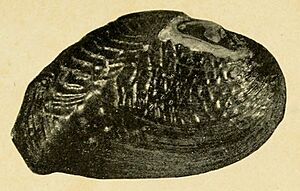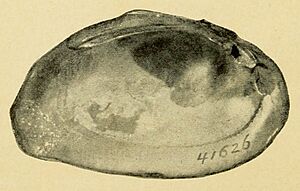Tapered pigtoe facts for kids
Quick facts for kids Tapered pigtoe |
|
|---|---|
 |
|
| External shell structure of Fusconaia burkei from the original description of the species. | |
| Conservation status | |
| Scientific classification | |
| Genus: |
Fusconaia
|
| Species: |
burkei
|
| Synonyms | |
|
|
The tapered pigtoe (Fusconaia burkei) is a type of freshwater mussel. These mussels are aquatic animals that live in rivers and streams. They are a kind of bivalve mollusk, meaning they have two shells that hinge together, like clams. They belong to the family Unionidae, which are often called river mussels.
This species is found only in North America. Since 2013, it has been listed as a threatened species under the Endangered Species Act of 1973. This means it needs special protection to help it survive and thrive in the wild.
Contents
Discovering the Tapered Pigtoe
Who First Described It?
The tapered pigtoe was first officially described in 1922 by a scientist named Bryant Walker. He originally named it Quincuncina burkei. When a scientist describes a new species, they write a detailed report. This report is called the "type description." It helps other scientists identify the species later on.
What Does the Shell Look Like?
The shell of the tapered pigtoe is usually medium-sized. It has a somewhat rounded, rectangular shape. The shells are a bit puffed up and not perfectly even on both sides. The top part of the shell, near the hinge, is only slightly raised.
The shell's surface has special patterns. It has strong, rounded ridges, especially near the back. These ridges curve upwards sharply. In older mussels, the shell is often black or dark brown. Younger mussels might have brown or even greenish-yellow shells. Sometimes, faint green stripes can be seen on younger shells.
Inside the shell, there are special "teeth" that help the two halves fit together. These are called pseudocardinals and laterals. The inside of the shell, called the nacre, is usually a light purplish color. It can be deeper purple near the hinge and looks shiny or iridescent at the back.
Where Was It First Found?
The very first tapered pigtoe specimen used for its official description was found in Sikes' Creek. This creek flows into the Choctawhatchee River in Barbour County, Alabama. This location is known as the "type locality."
The species was named after Joseph B. Burke, who first discovered it in the Pea River in Elamville, Alabama. He found it there before it was officially described.
Where Do They Live?
So far, scientists know that the tapered pigtoe lives only in the Choctawhatchee River system. This includes the main river and its smaller streams and tributaries. Besides Sikes' Creek, they have also been found in other places like Blue Springs, the Pea River, Campbell's Creek, and Hurricane Creek.
Do All Tapered Pigtoes Look the Same?
No, not exactly! Even within the same species, there can be some differences. Scientists have noticed that the shape and patterns on the shell can vary. For example, some shells might be more pointed at the back, while others are more rounded. The surface patterns can also be stronger or weaker depending on the individual mussel and where it lives.
The largest tapered pigtoe shell ever found measured about 67.5 millimeters long, 38 millimeters high, and 23 millimeters wide. That's about the size of a small candy bar!




